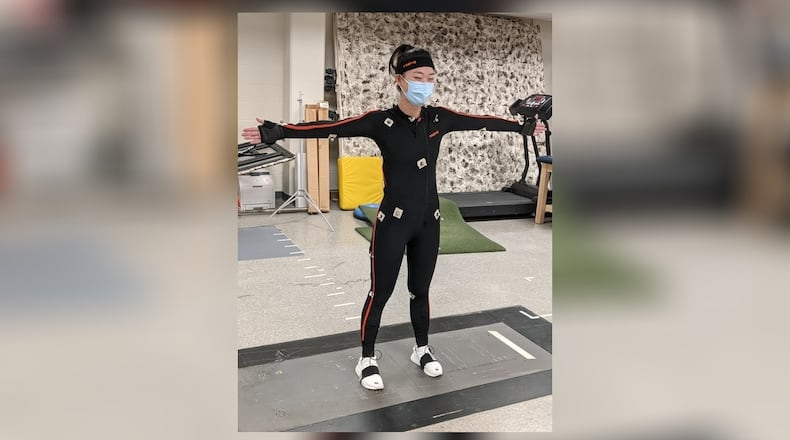There is, and it is available at Miami University in Oxford, where biomechanics professor Mark Walsh has teamed up with Young-Hoo Kwon, a professor of kinesiology at Texas Woman’s University, using innovative technology to unlock the secrets of an improved golf swing.
“Coming from the science side sport, everything we do is data driven, and I’m amazed that golf isn’t,” Walsh said. “But we’ve become a data collection center for professional and amateur golfers in the Midwest. We can show you that this is where you started, and this is where you’re at. Not only are you hitting the ball farther, but this is why. These are the concrete things that changed. You can see it. It gives the golfers validation, and it validates what we’re doing.”
Walsh, who came to Miami in 2001, had been working in Germany at a sports university where they did not teach but worked with athletes. He started with this program four years ago after attending an international conference at which the presenter — Kwon — asked for locations for Midwest data collection.
Walsh said he is not a golfer but is toying with the idea of taking it up after working with professional and amateur golfers all year.
The process uses high-tech integrations including reflective markers and force plates to provide computer-generated 3D models of golfers taking different kinds of swings. An infrared quadrascopic camera also calculates ball speed, distance, trajectory and spin, as well as how far the ball will bounce or roll backwards after hitting the ground.
The golfer’s motion is recorded in a computer program in the form of stick figures indicating the stress and pressure points over the body which can be read to determine potential improvements in the swing. Walsh compared it to Hollywood’s work with characters in “Lord of the Rings” as the fictional characters were created. The equipment provides a look at the body from every angle for a full-range picture of the effect of the golfer’s swing.
“It shows how to improve performance and avoid injury,” he said. Some sports, such as ice hockey, are difficult to work with on the equipment but it works well on baseball for both pitchers and hitters as well as gymnastics and basketball. The equipment is being used in an injury study of women’s basketball. “Golf makes the money to support the lab.”
Their focus has so far centered on the long-distance drive and that has helped golfers and golf coaches take a look at common practices and approaches with an in-depth look into the biomechanical sequence of the swing.
Walsh and Kwon have already worked with several pro golfers and many top amateur golfers across the Midwest, as well as with high school golf coaches and student athletes across Ohio. There are some golfers they see several times a year allowing them to track improvements over time with about half of the golfers they see being “repeat customers.”
Kwon has been doing this work for 15 years and comes to Oxford from Texas several times a year for a weekend of testing and reading results.
“He can look at people and make suggestions. The weight plate will show shifts (in the body). If you watch golf on TV, you’d see golfers he has worked with, but he’s not allowed to tell who he works with. Golfers are very territorial,” Walsh said, adding there are other applications for use of the equipment. “We do a lot more than that.”
Sports figures may be the more visible candidates for learning from use of this equipment but it can provide other valuable information in other areas.
One such area is Parkinson’s research. Walsh explained even when people are standing still, they still sway at least slightly. A person with Parkinson’s will have a “controlled” sway, while a ballerina will have a “chaotic” sway. Another scientific research project is currently on hold because other things came up, but they will return to work comparing the pressure stance of people missing a leg as part of a project to research prosthetics.
Still, it’s golf which supports the lab’s equipment.
“It’s adjacent to what we do,” he said, but their golf research provides a lot of useful information. “We know all the forces going through each leg in three dimensions, and all the movements their bodies are making. And we can give them tips on how to improve their swing, and decrease their chance of injury. We see some really subtle things that the naked eye cannot see if you’re just visually watching a golfer.”
For a $600 lab fee, anyone interested in having their swing analyzed can sign up.
About the Author
